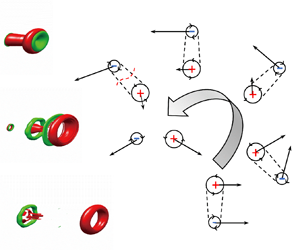Article contents
The formation process of annular starting jets
Published online by Cambridge University Press: 06 October 2022
Abstract

The formation and evolution process of the outer vortex ring (denoted as OV0) in annular starting jets has been studied numerically at stroke ratio  $3\leqslant L_m/D\leqslant 8$,
$3\leqslant L_m/D\leqslant 8$,  $\beta \leqslant 0.8$ and Reynolds number
$\beta \leqslant 0.8$ and Reynolds number  $400\leqslant Re_{\triangle R}\leqslant 1400$, where
$400\leqslant Re_{\triangle R}\leqslant 1400$, where  $D$ is the outer diameter of orifice,
$D$ is the outer diameter of orifice,  $L_m$ is the length of the fluid column,
$L_m$ is the length of the fluid column,  $\beta$ and
$\beta$ and  $\triangle R$ are the ratio and difference between inner and outer radii of the annular orifice, respectively. The initial formation process of OV0 is found to be similar to that of the leading vortex ring in a circular starting jet, but the circulation strength is relatively lower and decreases gradually with increasing
$\triangle R$ are the ratio and difference between inner and outer radii of the annular orifice, respectively. The initial formation process of OV0 is found to be similar to that of the leading vortex ring in a circular starting jet, but the circulation strength is relatively lower and decreases gradually with increasing  $\beta$. The pinch-off process will also appear after OV0 grows to a certain size but is different from that of the circular starting jet. On one hand, OV0 is stretched and deformed by the strain field generated by the trailing jet's instability, and vorticity would be shed. On the other hand, OV0 accelerates the irrotational fluids around it under viscous action so as to form the induced velocity field, which would consume energy causing it to shed vorticity further under the limit of the Kelvin–Benjamin variational principle. Furthermore, OV0 would eventually become a stable vortex ring whose non-dimensional circulation (
$\beta$. The pinch-off process will also appear after OV0 grows to a certain size but is different from that of the circular starting jet. On one hand, OV0 is stretched and deformed by the strain field generated by the trailing jet's instability, and vorticity would be shed. On the other hand, OV0 accelerates the irrotational fluids around it under viscous action so as to form the induced velocity field, which would consume energy causing it to shed vorticity further under the limit of the Kelvin–Benjamin variational principle. Furthermore, OV0 would eventually become a stable vortex ring whose non-dimensional circulation ( $\varGamma /(U_{0max}D$)) is found to be between 0.59–0.62 and it would not change with different
$\varGamma /(U_{0max}D$)) is found to be between 0.59–0.62 and it would not change with different  $L_m/D$ at
$L_m/D$ at  $\beta =0.5$, which is much less than the 2–2.5 of circular starting jets.
$\beta =0.5$, which is much less than the 2–2.5 of circular starting jets.
JFM classification
Information
- Type
- JFM Papers
- Information
- Copyright
- © The Author(s), 2022. Published by Cambridge University Press
References
- 7
- Cited by


